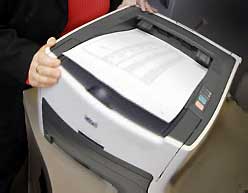The identity and origin of tiny, potentially hazardous particles emitted from common laser printers has been revealed by a new study at Queensland University of Technology (QUT).
Prof Lidia Morawska from QUT's International Laboratory for Air Quality and Health led the study, which aimed to answer questions raised by earlier findings that almost one third of popular laser printers emitted large numbers of ultrafine particles.
These tiny particles are potentially dangerous to human health because they can penetrate deep into the lungs.
Prof Morawska said the latest study found that the ultrafine particles formed from vapours that are produced when the printed image is fused to the paper.
'In the printing process, toner is melted and when it is hot, certain compounds evaporate and those vapours then nucleate or condense in the air, forming ultrafine particles,' she said.
'The material is the result of the condensation of organic compounds that originate from both the paper and hot toner.'
The study compared a high-emitting printer with a low-emitting printer and found that there were two ways in which printers contributed to the formation of these particles.

'The hotter the printer gets, the higher the likelihood of these particles forming, but the rate of change of the temperature also contributes,' Prof Morawska added.
'The high-emitting printer operated at a lower average temperature, but had rapid changes in temperature, which resulted in more condensable vapour being emitted, while the printer with better temperature control emitted fewer particles.'
Prof Morawska said the research provided information that would help consumers better understand the risks of laser printers and would help the printer industry to design low or no-emission printers.
A paper on the subject is available at: http://pubs.acs.org/doi/abs/10.1021/es802193n.




Project to investigate hybrid approach to titanium manufacturing
What is this a hybrid of? Superplastic forming tends to be performed slowly as otherwise the behaviour is the hot creep that typifies hot...